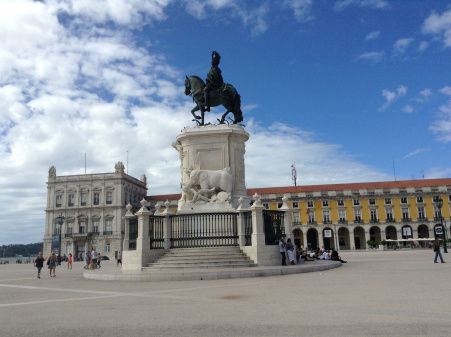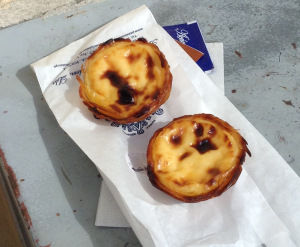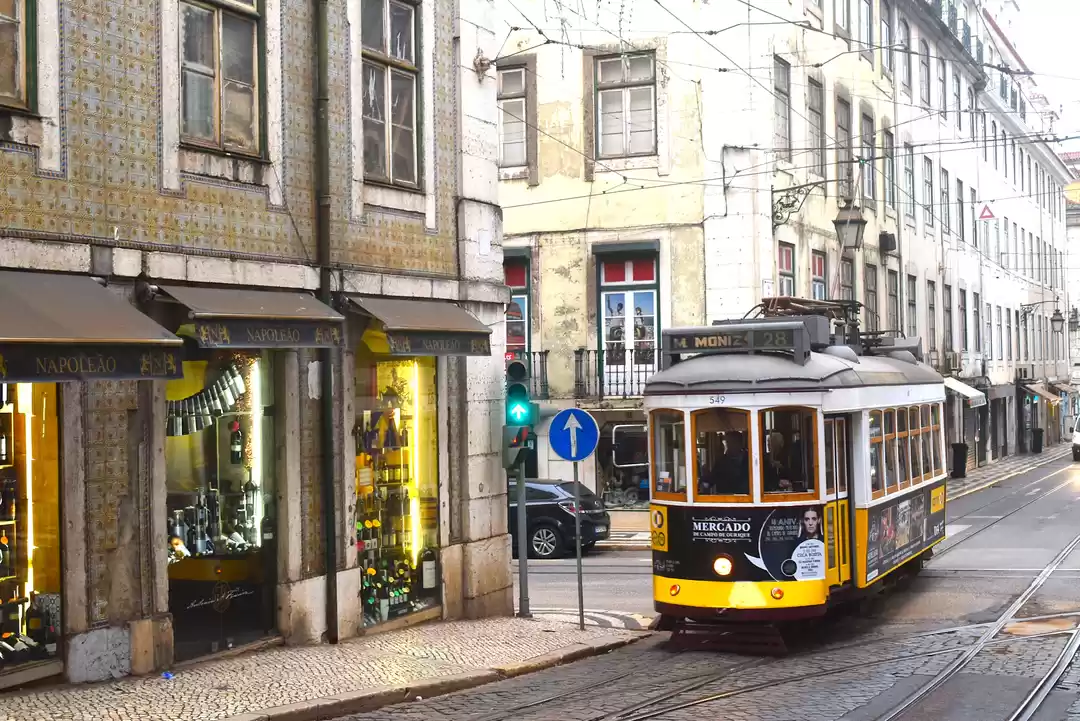

















I won’t lie to you – this is not the best blog for finding out about historical monuments, art galleries, museums or other things you’ll find on your must-see itinerary. When I travel, I like to wander around, go on public transport, eat where the locals eat (if I can find this) and generally just try to get a feel for the vibe of the place. Occasionally I’ll go see something – if it looks really cool – but I usually find that the “must-sees” are expensive, disappointing and crammed full of people.
This September, Jeff and I headed to Lisbon for four nights (to celebrate his birthday). We found very reasonable accommodation through http://www.airbnb.com – a guy’s flat, right in the centre of Bairro Altro, which is a very trendy part of Lisbon – great if you like to party, not so great if you like peace and quiet when you fall asleep. The flat itself was a very reasonable £25 a night (for a whole flat) and had everything we needed. The air con was loud enough to drown out the late-night partying outside, which stops at around 4-5am and is replaced a few hours later with the sounds of the local school, where the children seem to play for the entire day.
We got in late on a Saturday night; the flat owner had left the key under a rock for us as he had ended up at a late dinner party with his family. Bairro Alto is pretty easy to get to from the airport – you can get there on the underground/metro. You have to buy something called a Viva Viagem card, which is 0.50 euros. This is a little piece of cardboard that you “top up” with credit every time you want to travel. It’s a bit of a crazy system – each day, you can either go for a “day pass” (if you’re doing a fair bit of travelling) or you can just top it up with a specific amount. At the ticket machines, the easiest thing to do is get a ticket and load it up with around 5 euros – of course, if you don’t use that within a day it’s still there; if you wanted to put a “day pass” on it the next morning, presumably the remainder of the 5 euros would wait for the following day.
Anyway, the flat was up a cobbled street lined with bars and draped with carnival-like decorations. As the sun set, the streets filled with youngsters. The bars are so small, generally, that the party spills out onto the street; everyone talks to everyone, most people are visiting from other countries, and the mojitos are anything from 3 to 6 euros. We let ourselves into the flat and promptly came outside again to look for food. The Portuguese generally eat dinner at around 10pm, it seems, so finding a late-night restaurant is no problem – in fact, if you want to avoid the crowds, go for dinner at 7 or 8pm.
We were on Rua da Atalia; if you walk around the area, you’ll find tons of restaurants, tapas bars and Fado (traditional Portuguese music) restaurants. On our first night, we ended up in a random restaurant (sorry, kids, I can’t remember the name) where we grabbed some cod-related dishes. I had Bacalhau á Brás (the accents may be wrong, please correct me) – something like shredded cod, onions and potatoes fried up with eggs. Cod (bacalhau) is basically the most common thing you’ll find around Lisbon, although most restaurants offer a wide range of delicious seafood – at far more reasonable prices than the UK! I think we paid 18 euros all together for two seafood dishes and two glasses of very nice house red.
We wandered around the narrow, cobbled party streets for a while, trying a mojito or two, before heading to bed.
Our first real day in Lisbon started off (after finding some nice pastries, which you can find anywhere!) with a leap onto the historic Tram 28 – one that is, admittedly, recommended for the tourists. We had no idea where we were going and stayed on the tram until the end. Lisbon’s trams are pretty cool, mostly small and yellow; we were lucky when we got on it, as there weren’t many people there. However, when we were kicked off at the other end, a massive queue suddenly appeared. We decided we might as well get back on it, but for some reason (the driver tried to explain this in English) the route now changed into the route of the 25 tram. We ended up down by the coast, near the metro stop Terreiro do Paço.
We took a pleasant walk along the coast to Cais do Sodre station, where you can also take a train out to Cascais (or several other beach stops along the way). For this, we had to buy a new Viva Viagem card because we had already bought “day passes” with our current ones, and the journey extended out of those zones, or something like that. Anyway, the train took around 35 minutes and we ended up in Cascais, a lovely beach town.
Sadly the beaches were a little disappointing – quite small, a little bit dumped in the middle of the town, and it didn’t really feel warm enough to get in the sea. Still, it was a pleasant town to walk around, and we found some great food over at the Jardim dos Frangos (chicken garden?). Although their speciality was apparently grilled chicken, I ended up with another cod dish – this type bacalhau com natas; a kind of creamy potato bake, with cod. Jeff had swordfish, and I must say it was lovely and again, pretty nicely priced (main were between 8 and 10 euros) – but still a bit too much in the tourist realm of prices for my real liking.
After a while, we decided to head back to Lisbon. Seeing that the train stopped at Belem, we decided to get off there and have a look around. Belem is where a lot of Lisbon’s sights are located; Belem Tower, the Ajuda Palace, Belem Palace, the 25 de Abril Bridge… oh, there are lots of things. There’s also a shop/café that’s famous for its pasteis del nata (custard tarts) and has huge queues.
I’ll be honest again though… we forgot to take our good camera with us on holiday. All photos are from my iPad camera. I didn’t really want to be THAT tourist, taking iPad shots everywhere, which is why there aren’t really that many pictures. So again, there aren’t many shots of lovely architecture – although Lisbon has plenty of it. Instead, I managed to take some pictures of the custard tart place…
Yes, they were nice. They gave you a little packet of cinnamon to sprinkle on top and everything. However, you can get these pasteis pretty much anywhere in Lisbon, and in my uncultured opinion they’re just as good in other places. The difference is that Pasteis de Belem follow an original recipe, I think!
Also, here’s Jerónimos Monastery in Belem. It looked stunning, but we were too stingy to go in.
We then realised that we were vaguely near the LX Factory, which is where an old warehouse has been converted into a quirky marketplace. We took a (very crowded and hot) tram from Belem over to the stop Calvário, which is pretty close to the factory. It’s actually called Cantina LX and it’s quite cool – clothes, home items, food, a little bit like Camden market or something.
Back in central Lisbon, we spent the evening wandering around the trendy area around Rossio. From here, the streets seem much cleaner and full of designer shops and restaurants with touts; the castle, lit up on the top of its hill, beams down at you and you know you’re in the “tourist area”. We tried to be cool and find an unusual or quirky restaurant, but our Rough Guides book led us to three places that had closed down (despite the book being a year old) and our wanderings down dark streets didn’t fill us with confidence. In the end, we let ourselves get led to a random restaurant, where we experienced amazing salmon and house wine.
We followed this up by taking the lift to the Sky Bar at the top of the Tivoli Hotel, which is down “Liberty Avenue”. Yes, a cocktail will fetch 10 euros here, but we shared one so we could take in the night-time view of the city, including the castle, while lounging on their lovely soft chairs. My iPad camera didn’t quite manage to capture the moment, but I’ve scoured the web to find you another lovely picture of Lisbon at night, to give you some idea…
Shameless photo-stealing aside, let’s move on to the next day. We wanted to get to Sintra – my main objective was to see the Pena Palace. It looks amazing. Sadly, when we got there, it was raining and covered in scaffolding – plus we found that it would have cost us loads to get in; you had to pay separately for a ride up the (pretty steep) hill, into the actual palace itself, plus to seemingly do anything else within the grounds.
You can take a train from Rossio to Sintra; it takes about 40 minutes and costs around 4.30 euros. From the station, it’s 5 euros for a ticket that takes you on the National Palace – Castelo dos Moros – Pena Palace loop, although you can’t pass the starting point again, essentially forcing you to follow a set order. We skipped the National Palace, but got off at its stop – this is the centre of the village in Sintra, and is where you’ll find cafés and shops. We searched around, up slippery cobbled streets, to find an umbrella – as it had started raining heavily. We found some small umbrellas for 5 euros each.
The bus ride up to the Castle is very, very steep and winding. If you haven’t managed to grab a seat, make sure you have something to hold on to – it was hard to avoid falling into fellow passengers’ laps! When you finally reach the top of this mountain, you’re greeted by a lovely walk along the castle walls, where you can look down into Sintra and beyond. On a clear day you can see mountains, trees and the Pena Palace from afar, but on this occasion it was ridiculously misty and we couldn’t see much.
Finally, we got off at Pena Palace (a 5 minute ride from the castle). I have to say that I was quite disappointed; the queue was massive, and it was 7.50 euros just to get into the grounds – a further 5 or so to get into the palace, and more to take a bus up the hill. We decided to pay for access to the grounds, as I really just wanted to see the palace from the outside, up close. In pictures, it looks amazing (this is not my picture:)
Yeah! How could you not want to see this crazy, colourful patchwork of towers and madness? Sadly, I forgot to factor in that a) I would not be visiting by helicopter and b) the palace was covered in scaffolding! This, combined with the rain, means that we had a nice walk around a forested path for a while, but didn’t really manage to take any good photos or really see anything at all.
A little disappointed, we headed back to the train station and back to Lisbon. We essentially spent the rest of our time wandering about with no real agenda, so here’s some of the other stuff we did:
Here’s Jeff at the Cervejaria Trindade, Lisbon’s oldest beer hall. The walls are adorned with pretty cool old tiles, they brew their old beer – which is pretty good – and they serve plenty of sea food (although the prices crept up a little too much for our liking). It’s a little touristy, but perhaps worth a visit; especially during the day when it won’t be as crowded.
For our evening meal, we walked up from where we were staying onto Rua Dom Pedro V and started walking to the West. Somewhere along the road, we found a lovely little restaurant – I’m afraid I can’t remember the name at the moment, but somewhere on the left, on a corner, there’s a restaurant that looks pretty full and doesn’t have an Englis menu. We had some amazing red house wine for 4 euros (for a litre!) and some great swordfish for around 8.
The next morning, we walked a little to the east from Rua Atalia, up to the Elevador da Gloria – one of the funiculars. You can catch the tram down the hill or walk down the steps, although it’s a little steep and slippery after rain. Before you start walking, make sure to catch the lovely view of the city:
We wandered around the restaurants near Rossio again, and found lunch at a small place along Rua Augusta (the street through the beautiful stone arch). The restaurant itself was hidden behind scaffolding, we were the only customers, and it was 8 euros for THIS much salmon:
To be fair, in most restaurants we went to, you could get around this much salmon for 8-10 euros! In the UK, you’d be lucky to pay £10 for a quarter of this amount. So, if you like salmon, Lisbon is a good place to go.
Finally, we wandered around Alfama – a historical part of the city where you can catch traditional Fado music; the Castle, and the area around the castle. In retrospect, I regret that we didn’t do anywhere near as much as we could have done, but there we go – Lisbon is a lovely place just to walk around. Its cobbled streets reminded me of Prague, but it was distinctly a Latin American vibe; especially with the “bathroom tiles” they like to use on their buildings!
Lisbon actually has tuk-tuks – and here, in Alfama, you’ll see that it has plenty of what every other tourist destination has – plenty of gormless tourists with no sense of spatial awareness:
And, finally, it apparently just wouldn’t be Portugal without a big cockerel.











































